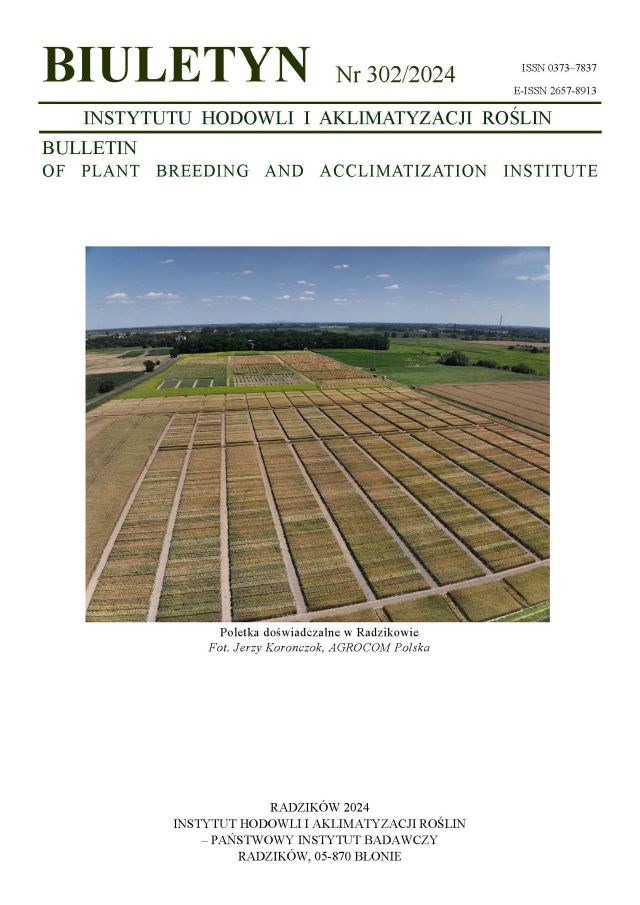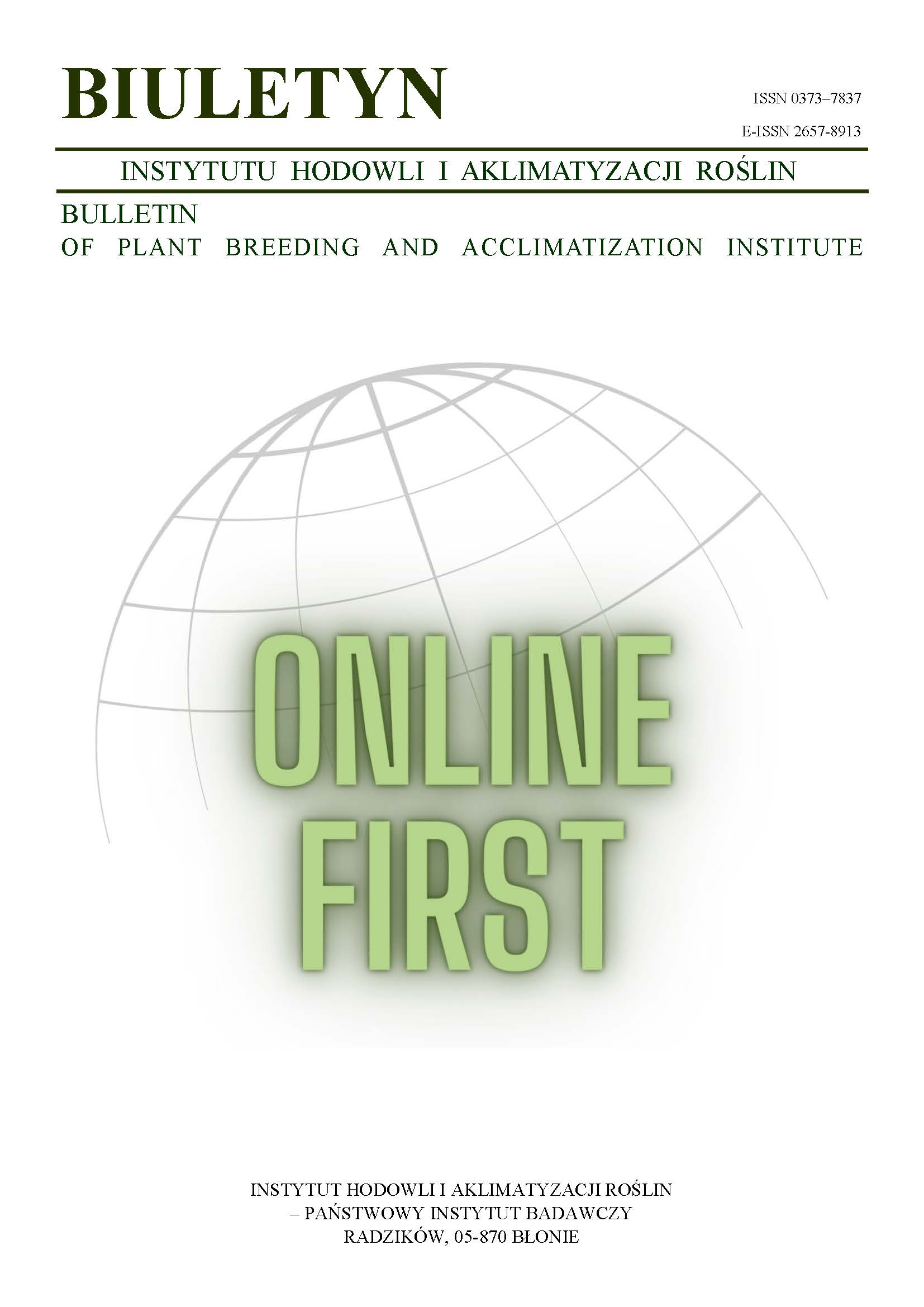The effects of organic fertilization and of methods of haulm destroying on plant health and tuber yield on seed potato plantations in the 4th degeneration zone
Maria Pytlarz-Kozicka
iaipr@upwr.edu.plKatedra Szczegółowej Uprawy Roślin, Akademia Rolnicza, Wrocław (Poland)
Abstract
The aim of the investigations was to determine the effect of farmyard manure or aftercrops organic fertilization and of methods of haulm destroying on plant health, yielding and tuber structure in two potato varieties. The three-factor split-plot experiments were carried out in 2000–2002 at the Plant Experimental Station in Pawłowice near Wrocław. Virus infection of potato plants increased in the successive years of reproduction. This resulted both from genetic traits of potato varieties and weather conditions that were favourable for aphid incursion onto crops. In the third year of reproduction (2002) the proportion of plants infected with viruses (PVY, PLRV and PVM) ranged from 60.6% when haulm was destroyed by chemical treatment up to 72% when haulm withered naturally. Earlier destroying of potato haulm mechanically or with Reglone reduced the incidence of infection. Genetic traits of the investigated varieties had a considerable effect on the total tuber yield, commercial tuber yield and seed potato yield as well as on percentage share of the latter two yields in the total yield. In contrast, neither earlier destroying of haulm nor a type of organic fertilization did affect tuber yield or its structure, although earlier haulm destroying resulted in the tendency to lower the total yield, and to increase the seed potato yield. Variety Balbina compared to var. Mila was characterized by considerably higher total tuber yield and commercial tuber yield, and by the greater share of the latter in the total yield. Moreover, it produced tubers of the greater average weight. In turn, the yield of seed potato produced by var. Mila, and its share in the total yield, exceeded those obtained with var. Balbina.
Keywords:
disease resistance, haulm destroying, organic fertilization, seed potatoes, varieties, virus infectionReferences
Bernstein L. 1975. Produkcja sadzeniaków ziemniaka. PWRiL Warszawa: 5 — 32.
Google Scholar
Borecki Z. 1996. Nauka o chorobach roślin. PWRiL Warszawa: 136 — 139.
Google Scholar
Ceglarek F., Płaza A. 1999. Wpływ nawożenia wsiewkami międzyplonowymi na jakość ziemniaka. Konferencja Naukowa. IHAR Radzików 23–25 II 1999: 117 — 119.
Google Scholar
Gabriel W. 1965. Rejony degeneracji ziemniaków w Polsce. JUNG Warszawa-Puławy 1965.
Google Scholar
Gabriel W., Bartoszuk W., Ładomirska J. 1973. Wczesne niszczenie naci w produkcji nasiennej zrejonizowanych odmian ziemniaka. Cz. I Odmiany wczesne i średnio wczesne. Biul. Inst. Ziemn. 11: 61 — 86.
Google Scholar
Gabriel W. 1982. Uprawa ziemniaków na sadzeniaki. PWRiL: 10 — 58.
Google Scholar
Gruczek T. 1995. Efektywność produkcji ziemniaka na glebie lekkiej w warunkach gospodarki bezobornikowej. Ziemniak Polski 4: 13 — 21.
Google Scholar
Grześkiewicz H. 1994. Poplony ścierniskowe jako cenny nawóz organiczny pod ziemniaki. Ziemniak Polski. 4: 11 — 14.
Google Scholar
Jabłoński K. 2001. Jesienią obornik pod ziemniaki. Agrochemia 10: 29 — 31.
Google Scholar
Jasińska Z., Kotecki A. 1999. Szczegółowa uprawa roślin. Wydawnictwo AR Wrocław, tom 2: 63 — 79.
Google Scholar
Styszko L. 1990. Studia nad wpływem wybranych czynników przyrodniczych oraz agrotechnicznych na plon i jakość sadzeniaków ziemniaka. Rozprawa habilitacyjna: 37 — 57.
Google Scholar
Trętowski J., Wójcik R. 1991. Metodyka doświadczeń rolniczych. WSPR — Siedlce: 303 — 372.
Google Scholar
Turska E. 1989. Stosowanie preparatów chemicznych ograniczających szerzenie się wirusów na plantacjach nasiennych. XXII Sesja naukowa 8–9 III 1989 Inst. Ziemn. Bonin: 51 — 53.
Google Scholar
Turska E. 2001. Produkcja sadzeniaków ziemniaka — zróżnicowane wymagania odmian. Ziemniak Polski 4: 4 — 12.
Google Scholar
Wróbel S. 1998. Sposoby niszczenia naci na plantacjach ziemniaka. Ziemniak Polski. 3: 18 — 22.
Google Scholar
Wróbel S. 2001. Jak zmniejszyć porażenie wirusami uprawy ziemniaka. Agrochemia 12: 17 — 20.
Google Scholar
Authors
Maria Pytlarz-Kozickaiaipr@upwr.edu.pl
Katedra Szczegółowej Uprawy Roślin, Akademia Rolnicza, Wrocław Poland
Statistics
Abstract views: 13PDF downloads: 7
License
Copyright (c) 2004 Maria Pytlarz-Kozicka

This work is licensed under a Creative Commons Attribution-ShareAlike 4.0 International License.
Upon submitting the article, the Authors grant the Publisher a non-exclusive and free license to use the article for an indefinite period of time throughout the world in the following fields of use:
- Production and reproduction of copies of the article using a specific technique, including printing and digital technology.
- Placing on the market, lending or renting the original or copies of the article.
- Public performance, exhibition, display, reproduction, broadcasting and re-broadcasting, as well as making the article publicly available in such a way that everyone can access it at a place and time of their choice.
- Including the article in a collective work.
- Uploading an article in electronic form to electronic platforms or otherwise introducing an article in electronic form to the Internet or other network.
- Dissemination of the article in electronic form on the Internet or other network, in collective work as well as independently.
- Making the article available in an electronic version in such a way that everyone can access it at a place and time of their choice, in particular via the Internet.
Authors by sending a request for publication:
- They consent to the publication of the article in the journal,
- They agree to give the publication a DOI (Digital Object Identifier),
- They undertake to comply with the publishing house's code of ethics in accordance with the guidelines of the Committee on Publication Ethics (COPE), (http://ihar.edu.pl/biblioteka_i_wydawnictwa.php),
- They consent to the articles being made available in electronic form under the CC BY-SA 4.0 license, in open access,
- They agree to send article metadata to commercial and non-commercial journal indexing databases.
Most read articles by the same author(s)
- Maria Pytlarz-Kozicka, Comparison of potato seed production in ecological versus conventional cultivation system , Bulletin of Plant Breeding and Acclimatization Institute: No. 255 (2010): Regular issue
- Anna Pęksa, Elżbieta Rytel, Agnieszka Tajner-Czopek, Agnieszka Kita, Maria Pytlarz-Kozicka, Joanna Miedzianka, The comparison of amino acid composition of the protein in preparations obtained from potato tubers cultivated within ecological and conventional systems , Bulletin of Plant Breeding and Acclimatization Institute: No. 266 (2012): Regular issue
- Maria Pytlarz-Kozicka, Planting density as a factor forming the structure of a potato plant , Bulletin of Plant Breeding and Acclimatization Institute: No. 232 (2004): Regular issue














